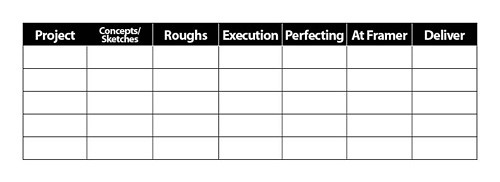Merlin’s weekly podcast with Dan Benjamin. We talk about creativity, independence, and making things you love.
Art & GTD
Brad Blackman | Apr 21 2006
This topic has been incubating in my brain the past few weeks, and I'm getting it to where it can be reasonably put together. It's partially a response to kenzi's thread, GTD and the creative life...possible? (N.B.-I haven't put it into practice yet for fine art, but I can see how it would work in theory since it works so well for design projects.) Art isn't always created in a linear fashion, but for the most part I'd say art creation usually follows this general process:
It occurs to me that these can be thought of as contexts to hook into GTD. Let's say you've been commissioned to do a painting for someone. You'll follow a process similar to this one, right? So to hook into the GTD ideology, you can move your project ("Painting for Mr. Z") from one context to another, and that will present next actions: "Come up with 5 rough ideas to present to Mr. Z," or "Finish highlights," or "Call framer to get their business hours so I can know when to take the painting there to be framed." I can imagine a wall of a studio being all or mostly corkboard: post pictures that inspire you, or reference material, or draw a simple chart that lets you move a project from one context/stage to another. There are variations on this that are possible.
I work at a design and marketing firm, and we have a similar chart on our wall on a 4 x 6 foot dry-erase board in our office. It lets us track our projects. The columns, going across, are: JOB# - PROJECT TITLE - FINAL DUE - IN DATE - NEXT REV. DUE - IN HOUSE - TO CLIENT - STATUS - DESIGNER. On the IN HOUSE and TO CLIENT columns, there are colored velcro dots that we place on there so we'll easily know the status of a particular job. The colors correspond to who's working on what project. My projects are blue, so I get blue dots, and everything about the project is written in blue. So you can tell that all the blue rows are mine, and those are the projects I'm working on right now, and (x) of them are in-house and (y) of them are out for client revision. I think a similar system can work for fine art projects, only without all the approval processes that commercial projects have. (Commissioned art is another story, though.) ### Now how about the non-project-tracking side of creativity? The part that generates ideas? One of the problems with fine art is that most of the time, you create your own work. (Of course, you can argue that the work creates itself, but for all practical intents, you are the one who determines what work you will do, rather than a boss telling you what to do.) So I think a good Someday/Maybe system should be in place to store ideas that come to you, a good way to capture those things that come to you. And a good way to archive and index those things, perhaps. Artists have done this for centuries with something called a Morgue, a collection of drawings, photos, found objects that inspire new artworks. My grandfather used to store photos and images of things he used to paint, sort of a library of images to draw from. Whenever he needed a chicken to go in this picture, he pulled out a file with photos of chickens, and found one that suited his watercolor piece, modifying it as he saw fit. My morgue is pretty scattered, with all sorts of images tossed into one really fat file. Most of it is stuff I think just looks cool. On my Mac's desktop I keep a folder for tossing images I like into it. Either method it works. They both provide inspiration for your art work, and are a valuable reference source, and should be treated as such. The thing is that it is a reference source full of potiential inspiration, and should be easily accessible. Whether you catalog things into categories and such is up to you. Some artists make their art by simply cataloging things and grouping them together in an almost neurotic fashion. So in a nutshell, my attempt at applying GTD to creativity is this: use contexts to move your projects along, and maintain a good Morge and Someday/Maybe file. And always carry a sketchbook or a camera, so you can capture things on the fly. 6 Comments
POSTED IN:
Great artical....Submitted by girdhar on December 12, 2007 - 3:06am.
Hi, Crome Now all things have become crystal clear to my mind .You really have given the practical definition of the what creativity should be..........thanks a lot crome. » POSTED IN:
|
|
| EXPLORE 43Folders | THE GOOD STUFF |


